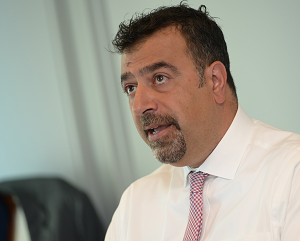Editor's note: Even as the Canadian economy roared ahead in 2017, the equity market has languished. Until recently, that is. In today's part 1 of our coverage of Morningstar's Canadian equity roundtable, the portfolio managers discuss what to expect after the TSX's September surge.
Our panellists:
Michael O'Brien, managing director and head of the core Canadian equity team at TD Asset Management Inc. His mandates include that of lead manager of TD Canadian Equity and TD Balanced Income. O'Brien's investment style is GARP, growth at a reasonable price.
A value manager, Hovig Moushian, senior vice-president, portfolio manager and head of the all-cap value team at Mackenzie Investments. His responsibilities include Mackenzie Canadian All Cap Dividend and Mackenzie Canadian All Cap Value.
Ryan Fitzgerald, senior portfolio manager and senior vice-president at Harbour Advisors, a separate portfolio-management group under the C.I. Investments Inc. umbrella. A value manager, Fitzgerald's responsibilities include CI Harbour, CI Harbour Corporate Class, CI Harbour Global Equity Corporate Class and CI Harbour Voyageur Corporate Class.
The roundtable was convened and moderated by Morningstar columnist Sonita Horvitch, whose three-part series continues Wednesday and concludes Friday.
Q: The Canadian equity market, which had a disappointing performance in the first eight months of 2017, started to do better in September. Why?
O'Brien: Since the beginning of September, the Canada equity market has come to life. This is encouraging. Hopefully, it retains this traction. Helping its September growth spurt was the partial recovery in the energy sector and a better showing from the financial-services sector. Still, the Canadian equity market has been among the poorest performing markets in the world so far this year, in local currency terms. While the S&P 500 Index has been setting new highs, the S&P/TSX Composite Index has yet to reclaim the highs that it set in February of this year.
Q: After a stellar 21.1% total return in 2016, the Composite did little in the first eight months of 2017, with a total return of 1.4%. By contrast, it had a total return of 3.1% in the month of September, making for a total return of 4.5% in the first nine months of this year. At the same time, the Canadian economy was roaring ahead. Why was there this decoupling?
 |
|
 |
|
| Michael O'Brien | |
 |
|
 |
|
 |
O'Brien: There are a number of factors weighing on the Canadian equity market. The most obvious one is energy and it is hopefully starting to turn. Fairly or unfairly, international investors associate the Canadian equity market, the TSX, with oil. The fact that oil went down in the first few months of 2017 took a lot of wind out of the sails of the Canadian equity market. Also, investors, particularly outside of Canada, are concerned about the Canadian housing market and the level of household indebtedness. Finally, there are concerns about the impact of President Donald Trump's protectionist strategies on the Canadian economy. The discussions under way on the North American free-trade agreement are causing some uncertainty.
Fitzgerald: The Canadian stock market is, in some ways, an exaggerated representation of the Canadian economy. Energy represents approximately 10% of the Canadian economy, yet it represents 20% of the Composite. Add the banks' massive representation in the index of about 23%, and you have 43% of the index in banks and energy. When people ask how the TSX is going to perform, what they are asking is: How are banks and energy going to perform? The strength in the Canadian economy was not being captured by the stock market because of the over-representation of some of the sectors.
Moushian: Energy's poor performance in the first eight months of 2017 substantially dragged down the performance of the overall equity market, even though most of the other sectors were in positive territory. A weak U.S. dollar is usually positive for oil prices and that relationship has not held. The oil price is starting to turn, and this reinforces my thesis that the Canadian energy sector is attractive at this stage.
O'Brien: In context, the Canadian equity market had a good year in 2016. Given the Composite's total return last year of 21.1%, the case could be made that the market had to pause to catch its breath. I hope that it has done so.
Fitzgerald: That pause is relevant to Canadian bank stocks, which had a stellar year last year. Valuations on these stocks going into 2017 were above their historical averages. As the banks have posted good earnings results and the stocks have not done much, you could say that they have grown into their average valuations.
 |
|
 |
|
| Ryan Fitzgerald | |
 |
|
 |
|
 |
O'Brien: The optimist would say that this is a good time to invest in the Canadian equity market.
Fitzgerald: Most people are tempering their expectations about the outlook for the Canadian economy. The blockbuster number of 4.5% for the annualized GDP growth rate in the second quarter of 2017 is not sustainable.
O'Brien: Some 12 months from now we may be explaining why the Canadian equity market did very well, while the Canadian economy's growth rate softened.
Moushian: Our primary focus is on equity valuations and we consider that overall market valuations are extended. We have held this view for quite a long time. There are not a lot of good value opportunities in the Canadian equity market, from our perspective. The energy sector is an exception. I have not seen valuations that are this attractive in energy for a very long time. There is the prospect that valuations in energy will improve and that the energy sector can make a positive contribution to the overall market. From a broader Canadian economic perspective, I agree that we are probably in the later innings of this economic cycle.
Fitzgerald: Coming back to the question of valuation in the Canadian equity market. There is very little value to be had among the high-quality companies that are growing at a decent rate. Most quality stocks are priced for perfection. We are nine years into a bull market in Canada.
O'Brien: Valuations of equity markets around the world are elevated. But the Canadian equity market's advantage is that there are two heavily weighted sectors that offer opportunities -- energy and financial services. The Canadian equity market has been out of favour with investors for some time. You can see this in mutual-fund flows, which are pretty dismal looking at Canadian balanced and equity fund flows. Hopefully, this will turn.
Q: What about the flow of foreign funds into the Canadian equity market?
 |
|
 |
|
| Hovig Moushian | |
 |
|
 |
|
 |
Fitzgerald: The Canadian institutional investor and the average Canadian retail investor have a heavy exposure to banks, and to energy to a certain extent. To get the sectors moving, it is often the U.S. buyers or foreign buyers that like Canada or like energy, that make this happen. You have their faster money flowing into the Canadian banks and the Canadian energy sector. Those flows do not seem to be anywhere in sight. The foreign investor seems to have little interest in the Canadian banks, at present, unless it is to short them. On energy, institutional investors in places like the United States and Europe do not have to be exposed to the energy sector. They will do so only if they have a very bullish view of the oil price. This does not appear to be the case, at the moment.
Moushian: In addition to that, the Permian Basin in the United States, which is one of the most prolific oil and gas basins in the country, has been an area of huge excitement with the introduction of shale and horizontal drilling. There has been a lot of production growth coming out of there. Investors have been enthusiastic about stocks of companies with interests in the Permian, and a lot of Canadian oil stocks have been orphaned.
O'Brien: The universal consensus is that oil is trapped in a range of US$45 to US$55 a barrel. If one has that view, then none of these stocks, with a few rare exceptions, are that compelling. But, I do not think that we are going to stay in range of US$45 to US$55 a barrel. The first sign of a breakout would be a crack in the production of shale. I think that the oil price is headed higher. That is the investment opportunity.
Photos: Paul Lawrence Photography















